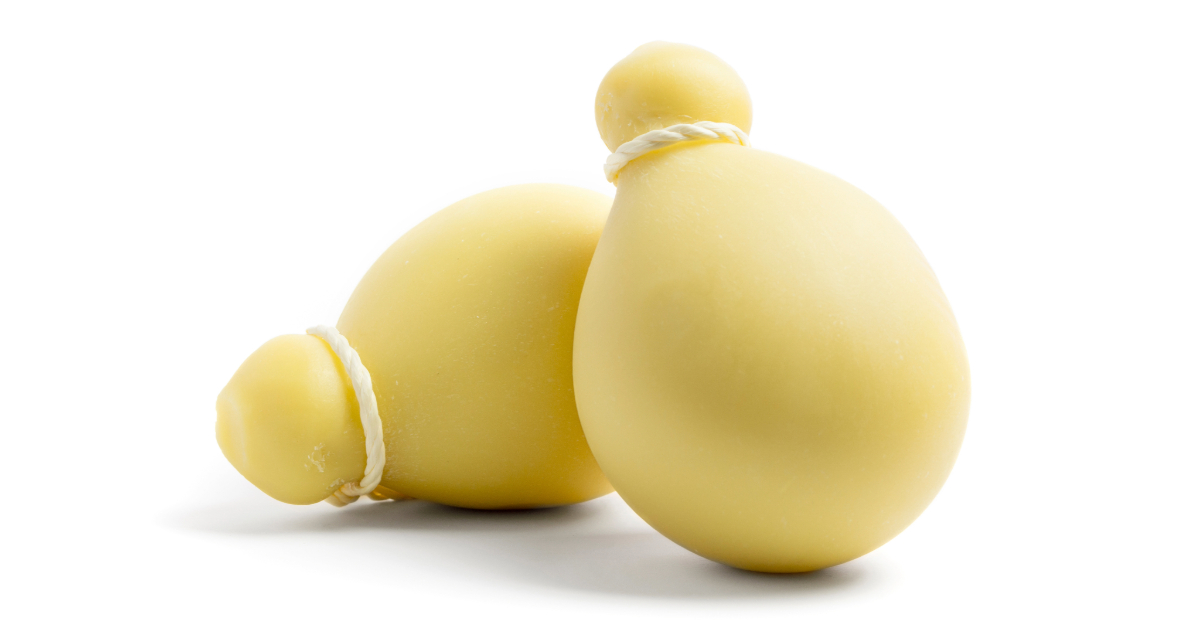Caciocavallo is a traditional Italian cheese with a uniquely complex flavor. Originally from southern Italy, it's made using a pasta filata technique that gives it a distinctive stringy, elastic texture.

If you don't have access to caciocavallo or can't find it in stores near you, several substitutes can mimic its taste and texture well enough to work in recipes calling for caciocavallo.
What Is Caciocavallo Cheese?
Caciocavallo is classified as a semi-soft to semi-hard cheese. Its texture changes as it matures, starting out soft and elastic when fresh and firming up as it ages over months.
The name "caciocavallo" translates to "horse cheese" in Italian. This odd name comes from the traditional way of aging caciocavallo, tied with a rope and hung over a wooden beam or rod to drain and cure, supposedly resembling a horse's body and neck.
Unlike most cheeses formed into wheels or blocks, caciocavallo has a distinctive teardrop or gourd shape with a knob at the top where the cheese was tied. The rind starts out thin and soft, hardening as it ages.
Caciocavallo can be made from cow, sheep, or goat's milk. Cow's milk versions are most common. The cheese can range from mild when young to tangy, piquant, and slightly spicy when aged for months. It has a complex, nutty flavor with hints of grass and sweetness.
Why Substitute for Caciocavallo Cheese?
There are a few reasons you may need or want to use an alternative cheese in place of caciocavallo:
- Caciocavallo isn't widely available outside Italy. It can be hard to find in regular supermarkets, especially certain regional varieties. You'll likely have to visit a specialty cheese shop.
- It's expensive. Imported Italian caciocavallo can cost $15-20 per pound or more. The price makes it impractical for recipes needing a lot of cheese.
- You need a younger cheese. Older aged caciocavallo may be too firm or tangy for a recipe calling for soft, mild melting cheese.
- You or someone eating it is lactose intolerant. Aged for months, caciocavallo contains very little lactose. Substituting a lactose-free cheese works better.
- You prefer a vegetarian cheese. Traditional caciocavallo is made with animal rennet. Vegetarian cheeses are better for vegetarians and those who keep kosher or halal.
Best Substitutes for Caciocavallo Cheese
Provolone
Fresh, soft provolone is the most direct substitute for caciocavallo. Aged provolone works for recipes needing aged caciocavallo.
With its smooth, dense texture and tangy, nutty flavor, provolone matches caciocavallo closely in taste and melting properties. Provolone dolce (mild, aged less than 3 months) substitutes well for young caciocavallo. Aged provolone piccante substitutes for older caciocavallo.
The main difference is provolone forms into cylinders or blocks rather than teardrops. Visually, some recipes may not look quite the same. The flavor and performance are very close.
Mozzarella
Fresh mozzarella makes a good substitute in dishes cooked or baked. Low-moisture or aged mozzarella works for replacing aged caciocavallo.
Mozzarella has a softer, creamier texture compared to caciocavallo but melts smoothly. Fresh mozzarella in particular has a mild, faintly sour flavor reminiscent of young caciocavallo.
For recipes like pizza where you want stretchy melted cheese, mozzarella performs similarly to caciocavallo. Part-skim or low-moisture mozzarella has a firmer texture suited to grating or slicing.
Key Takeaway: Fresh mozzarella and young caciocavallo have a similar mild, creamy flavor. Aged mozzarella works well instead of aged caciocavallo.
Asiago
Asiago is an Italian cow's milk cheese with a versatile semi-soft to semi-hard texture. Asiago pressato is aged 3-6 months, becoming firm and sliceable. Asiago d'allevo is aged 1-2 years, turning hard and perfect for grating.
Young Asiago has a mild, fruity taste similar to caciocavallo. Aged Asiago is tangy and robust like aged caciocavallo. The flavor profile and firm, granular texture when aged make it a good substitute in cooked recipes.
Scamorza
Scamorza is another Italian pasta filata cheese like caciocavallo. It has a similar pliable, stringy texture when fresh but doesn't age and harden as much.
In recipes needing melted cheese, scamorza makes an excellent substitute for caciocavallo. Both melt extremely well. Scamorza is often smoked, which adds flavor complexity.
Unripened scamorza has a fresh, light flavor. Ripened scamorza is tangy and rich. The mild milky taste of fresh scamorza resembles young caciocavallo.
Queso Oaxaca
Queso Oaxaca is a white, stringy Mexican cheese also made using the pasta filata method. It has a similar stretchy, melty texture to caciocavallo when heated.
Since it's not aged, queso Oaxaca remains soft and mild-flavored. Its melty properties make it a possible substitute in baked dishes or casseroles calling for caciocavallo. It won't mimic the tangy bite of aged caciocavallo.
Fontina
Fontina is a semi-soft cow's milk cheese from Italy's Aosta Valley. Mild when young, it develops nutty, earthy flavors when aged 3-4 months.
Young fontina makes a workable substitute for young, mild caciocavallo. Aged fontina isn't quite as hard as aged caciocavallo but substitutes reasonably well in cooking and grating.
Gouda
Smoked gouda imitates some of the complex flavor notes of aged caciocavallo. Regular gouda lacks the salty, tangy bite. Still, the smooth mouthfeel and good melting ability make gouda an option.
Aged gouda typically has a firm, dense texture suited to grating and slicing. Young gouda has a softer texture and milder taste similar to young caciocavallo.
Monterey Jack
Monterey Jack is a simple American cheese made using a pasta filata stretching process. The soft, supple texture melts extremely well.
Simple and mild when young, Monterey Jack resembles fresh caciocavallo in texture and low flavor impact. It melts well in baked dishes requiring caciocavallo.
The main downside is flavor. Jack cheese lacks the complexity and sharpness of aged caciocavallo. Use it for texture rather than flavor.
Key Takeaway: For melting ability, Monterey Jack matches caciocavallo's stretchy texture. The mild flavor doesn't mimic caciocavallo, though.
Queso Blanco and Panela Cheese
Queso blanco ("white cheese") and queso panela are fresh Mexican-style cheeses sold in blocks. Both have a crumbly texture when cold that becomes stringy and creamy when heated.
They make decent substitutes for caciocavallo in recipes where you need melting properties and mild flavor rather than replicating caciocavallo's exact taste.
Caciocavallo Cheese Substitute for Pizza
One common use for caciocavallo is on pizza. Low-moisture mozzarella makes the closest substitute for pizza cheese requiring stretchiness.
Pizza recipes sometimes call for a blend of cheeses. Use provolone, Asiago, or fontina along with mozzarella to approximate caciocavallo's flavor complexity.
Fresh mozzarella or queso Oaxaca also work on pizza needing soft melted cheese. Their milky flavors contrast well with other assertive pizza toppings.
Provolone works well in place of caciocavallo on pizza. Aged provolone provides more tang and flavor punch.
Substituting Cheese in Baked Pasta Dishes
In baked pasta recipes like lasagna, manicotti, or ziti, look for cheeses with good melting properties that won't turn rubbery or weep grease during extended baking.
Mozzarella ( preferably fresh mozzarella or low-moisture) makes an excellent substitute for caciocavallo in baked pasta. It melts smoothly into the creamy texture you want in these dishes.
For more complex flavor, use a blend of fontina and provolone or provolone and Parmesan. Asiago also has good melting properties and tangy flavor to stand in for caciocavallo.
Queso Oaxaca or Monterey Jack work for their melting ability but won't mimic caciocavallo's depth of flavor.
Vegetarian Caciocavallo Substitutes
If you need a vegetarian alternative to traditional caciocavallo made with animal rennet, these cheeses work well:
- Aged provolone can be found made with non-animal rennet. The flavor profile closely matches caciocavallo.
- Halloumi is a semi-hard Cypriot cheese made from sheep and goat milk with no animal rennet. Salty and tangy when cooked, it substitutes for caciocavallo in grilling or frying.
- Queso Oaxaca is usually made with either microbial or vegetable rennet. The stringy melting texture works great instead of caciocavallo.
- Aged gouda has a similar firm, granular texture to aged caciocavallo. Check the label to find gouda made with vegetable rennet.
- Most mozzarella produced today uses microbial or vegetable rennet. Fresh mozzarella and low-moisture part-skim mozzarella substitute well for caciocavallo.
Lactose-Free Substitutes for Caciocavallo
Aged for months to years, most caciocavallo contains little to no lactose. If you need lactose-free alternatives, these cheeses work well:
- Aged Asiago is essentially lactose-free, with less than 0.1 grams lactose per ounce—even less when aged over a year. The texture is suitable for grating or cooking.
- Aged Cheddar and Colby are low-lactose, with less than 0.5 grams lactose per ounce when aged over 10 months.
- Parmesan is naturally low in lactose thanks to aging. Authentic Parmigiano-Reggiano contains less than 0.5 grams lactose per ounce.
- Many hard goat cheeses like aged cheddar-style goat cheese are low in lactose.
Key Takeaway: Aged hard cheeses like Asiago, cheddar, Parmesan, and goat cheese are naturally low in lactose for lactose-free cooking.
Can You Freeze Caciocavallo Cheese?
Like most cheeses, you can freeze caciocavallo for long-term storage. Freezing prevents mold growth and extends the shelf life.
To freeze caciocavallo:
- Cut the cheese into portions to avoid repeatedly thawing and refreezing a large block.
- Wrap tightly in plastic wrap, pressing out air, then seal in an airtight freezer bag.
- Freeze for up to 2-3 months for best flavor and texture.
- Thaw in the refrigerator overnight before using.
FAQs
Is caciocavallo cheese pasteurized?
Traditionally caciocavallo was made from raw milk. But today most commercial producers pasteurize the milk as a food safety precaution.
Raw milk caciocavallo is still produced on some small farms and creameries using traditional methods. But raw milk cheeses aren't legal everywhere due to food safety concerns.
Pasteurized caciocavallo has a longer shelf life but may lack some of the depth and complexity valued by cheese connoisseurs.
Can you eat caciocavallo rind?
Yes, the rind on caciocavallo is edible. When the cheese is young, the rind is thin and soft enough to eat.
As caciocavallo ages, the rind becomes thicker and harder. Older rinds tend to be salty and tangy in flavor. The rind helps provide an interesting textural contrast to the softer interior when eating aged caciocavallo.
What wine pairs well with caciocavallo?
The bold, complex flavor of aged caciocavallo cheese pairs deliciously with full-bodied red wines like Barolo, Chianti Classico Riserva, Brunello di Montalcino, Amarone della Valpolicella, or Montepulciano d’Abruzzo.
Fresh young caciocavallo tastes wonderful with fruity white wines like Falanghina, Greco di Tufo, or Fiano di Avellino. Sparkling wines and dry rosés also complement mild caciocavallo.
Conclusion
Finding authentic caciocavallo cheese outside Italy can be a challenge. Luckily, excellent substitutes provide very similar textures, flavors, and cooking properties.
For the closest match, go with provolone or mozzarella. Queso Oaxaca and Monterey Jack make great substitutes for melting. Fontina, Asiago, and gouda work well too.

